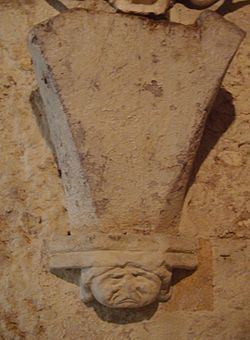Order Premonstratensian Public access No , Occupied Disestablished 1535 | Dedicated to Thomas Becket | |
 | ||
Founder(s) Sir William de Auberville Visible remains Monastic cellars and 12th century Ice House | ||
Langdon Abbey (grid reference TR329468) was a Premonstratensian abbey situated near West Langdon, Kent. The visible remains of the abbey are now confined to the extensive cellaring below the 16th-century house that occupies its site and small remains of a 12th-century Ice House .
Contents
Foundation
The abbey was founded by William de Auberville, an English jurist in the reign of Henry II, in about 1192 and was dedicated to the Blessed Virgin Mary and St Thomas the Martyr. Sir William annexed the church of St. Mary in Walmer to the abbey, in perpetual alms, and the church remained with the abbey until its dissolution.
Royal favour
In 1325 Edward II recuperated at the abbey, having been taken ill on the road to Dover.
The Abbot and Convent of Langedon were granted a licence to crenellate in 1348.
In 1491 it was reported that Langdon had 300 acres (121 hectares) of grain and a very good supply of animals.
Dissolution
In 1535 the abbey was reputedly the first religious house to be dissolved by Henry VIII and had, at that time, an annual revenue estimated at £56. Dr. Leyton, the commissioner who carried out the visitation of the abbey, sent the following report to Cromwell on his arrest of the abbot and his mistress:
"Please it your goodness to understand that on Friday, the 22nd of October, I rode back with speed to take an inventory of Folkstone, and from thence I went to Langden. Whereat immediately descending from my horse, I sent Bartlett, your servant, with all my servants, to circumspect the abbey, and surely to keep all back-doors and starting-holes. I myself went alone to the abbot's lodging, joining upon the fields and wood, even like a cony clapper, full of starting-holes. [I was] a good space knocking at the abbot's door; nec vox nec sensus apparuit, saving the abbot's little dog that within his door fast locked bayed and barked. I found a short poleaxe standing behind the door, and with it I dashed the abbot's door in pieces, ictu oculi, and set one of my men to keep that door ; and about the house I go, with that poleaxe in my hand, ne forte, for the abbot is a dangerous desperate knave, and a hardy. But for a conclusion, his gentlewoman bestirred her stumps towards her starting-holes; and then Bartlett, watching the pursuit, took the tender damoisel; and, after I had examined her, [brought her] to Dover to the mayor, to set her in some cage or prison for eight days; and I brought holy father abbot to Canterbury, and here in Christchurch I will leave him in prison."Later history
The fee of the manor was acquired by John Master, who died in 1588. His son, James Master (who died in 1631, aged 84) was described as "Primo de Sandwich, postea de East Langden, ubi edificavit mansionem". James Master's second and eldest surviving son, Sir Edward Master, was High Sheriff of Kent in 1639.
The site of the abbey itself was occupied by a farm house, parts of which date back to the 16th century. The monks’ cellar (retaining its original arches) remains in place underneath the house. In 1828, it was reported that the farm house "has been occupied many years by a respectable family of the name of Coleman", and the returns from the 1881 census show that one Richard Coleman remained a substantial farmer at Langdon as at that date.
